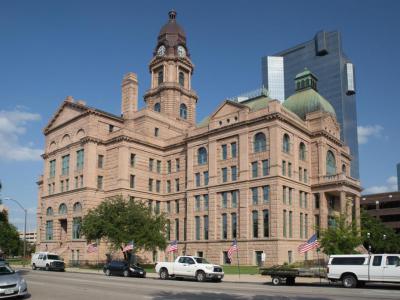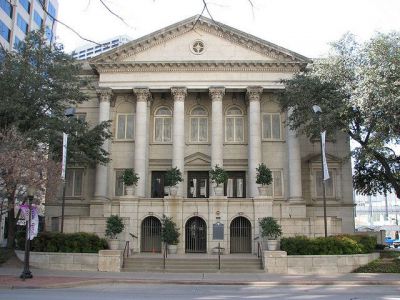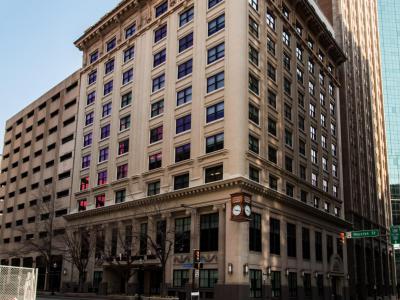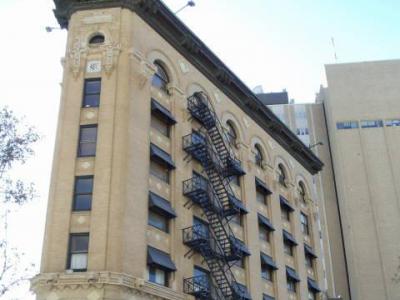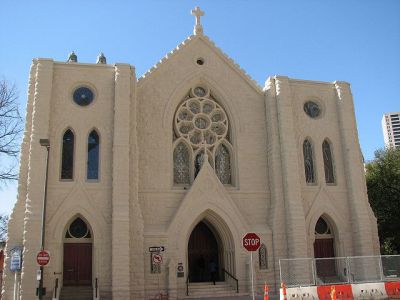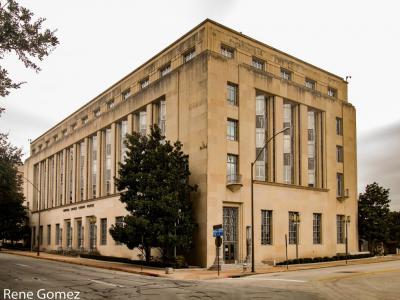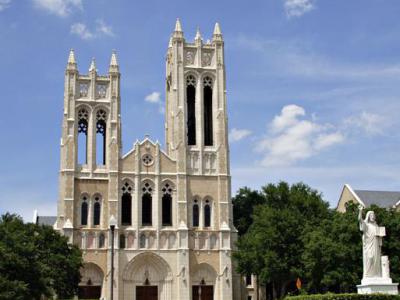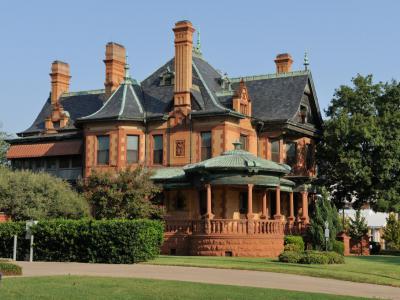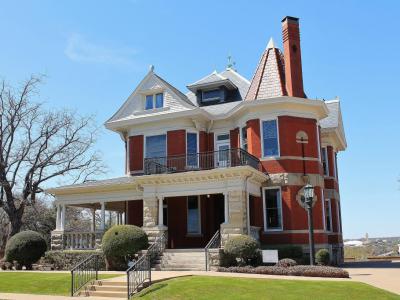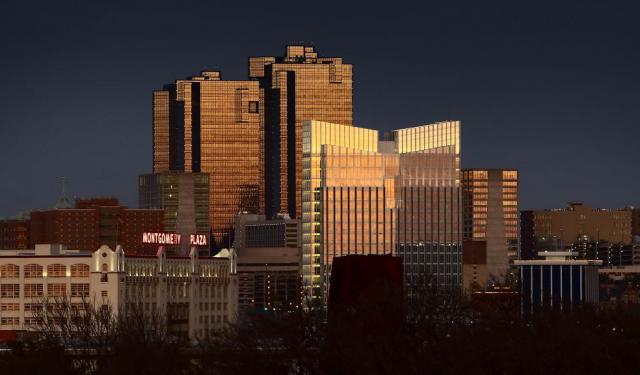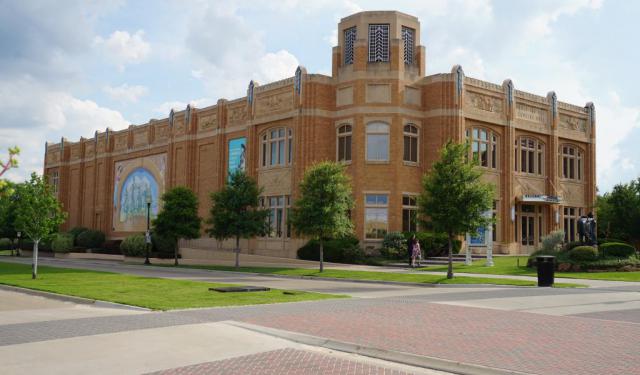Fort Worth Historical Buildings (Self Guided), Fort Worth
Among the many ways to explore the richness of heritage fabric in Fort Worth there is one by historical architecture. Back in the 1920s-30s, the majority of Fort Worth’s notable buildings were designed by either Sanguinet & Staats or Wyatt Hedrick.
The former, in particular, were responsible for creating, among other structures, the Flatiron – one of the first high-risers in Fort Worth. The design was inspired by the Flatiron Building in Manhattan; the second floor of the Fort Worth namesake is lined with panther head gargoyles, a nod to Fort Worth’s nickname “Panther City."
The Downtown area, known for its unique rustic architecture, is dominated by Art Deco style. The Tarrant County Courthouse, a distinctive local landmark since its completion in 1895, features the American Beaux Arts design, with some decoration elements and granite used on the facade bearing striking resemblance to the Texas State Capitol building in Austin.
Most of the edifices surrounding Sundance Square, like The Knights of Pythias Building, The Burk Burnett Building, and The First Christian Church, have preserved their original, early 20th-century façades to this day. The Burk Burnett Building, in particular, is an excellent example of Neoclassical hi-rise architecture in Fort Worth, prominently standing 12 stories over the plaza.
Given that most of the city's noteworthy structures, these and others, are in close proximity to each other, the best way to observe them is on foot. And if you intend to embark on an architectural journey in Fort Worth by yourself, it is best done with the help of our self-guided tour!
The former, in particular, were responsible for creating, among other structures, the Flatiron – one of the first high-risers in Fort Worth. The design was inspired by the Flatiron Building in Manhattan; the second floor of the Fort Worth namesake is lined with panther head gargoyles, a nod to Fort Worth’s nickname “Panther City."
The Downtown area, known for its unique rustic architecture, is dominated by Art Deco style. The Tarrant County Courthouse, a distinctive local landmark since its completion in 1895, features the American Beaux Arts design, with some decoration elements and granite used on the facade bearing striking resemblance to the Texas State Capitol building in Austin.
Most of the edifices surrounding Sundance Square, like The Knights of Pythias Building, The Burk Burnett Building, and The First Christian Church, have preserved their original, early 20th-century façades to this day. The Burk Burnett Building, in particular, is an excellent example of Neoclassical hi-rise architecture in Fort Worth, prominently standing 12 stories over the plaza.
Given that most of the city's noteworthy structures, these and others, are in close proximity to each other, the best way to observe them is on foot. And if you intend to embark on an architectural journey in Fort Worth by yourself, it is best done with the help of our self-guided tour!
How it works: Download the app "GPSmyCity: Walks in 1K+ Cities" from Apple App Store or Google Play Store to your mobile phone or tablet. The app turns your mobile device into a personal tour guide and its built-in GPS navigation functions guide you from one tour stop to next. The app works offline, so no data plan is needed when traveling abroad.
Fort Worth Historical Buildings Map
Guide Name: Fort Worth Historical Buildings
Guide Location: USA » Fort Worth (See other walking tours in Fort Worth)
Guide Type: Self-guided Walking Tour (Sightseeing)
# of Attractions: 12
Tour Duration: 2 Hour(s)
Travel Distance: 3.5 Km or 2.2 Miles
Author: IreneB
Sight(s) Featured in This Guide:
Guide Location: USA » Fort Worth (See other walking tours in Fort Worth)
Guide Type: Self-guided Walking Tour (Sightseeing)
# of Attractions: 12
Tour Duration: 2 Hour(s)
Travel Distance: 3.5 Km or 2.2 Miles
Author: IreneB
Sight(s) Featured in This Guide:
- Tarrant County Courthouse
- Knights of Pythias Building
- Burk Burnett Building
- First Christian Church
- First National Bank Building
- Bryce Building
- Flatiron Building
- St. Patrick Cathedral
- Eldon B. Mahon United States Courthouse
- First United Methodist Church
- Eddleman–McFarland House
- Pollock–Capps House
1) Tarrant County Courthouse
The Tarrant County Courthouse, completed in 1895, is an important historic and governmental building serving Tarrant County. Designed by architects Frederick C. Gunn and Louis Curtiss, this Renaissance Revival-style structure was built using pink Texas granite sourced from central Texas, closely mirroring the design of the Texas State Capitol.
Its distinctive architectural feature is the prominent clock tower, reaching a height of 194 feet. The courthouse took over two years to build and cost $408,840-a sum that sparked controversy among local citizens, who considered the expenditure extravagant and consequently elected a new County Commissioners' Court in 1894.
Significant restoration took place in 1983, ensuring the building's preservation, followed by a major renovation of the clock tower in 2012, costing $4.5 million. Today, the Tarrant County Courthouse houses several important offices, including the Tarrant County Clerk’s Office, Probate Courts, County Courts at Law, a law library, and the Facilities Management Department.
Its distinctive architectural feature is the prominent clock tower, reaching a height of 194 feet. The courthouse took over two years to build and cost $408,840-a sum that sparked controversy among local citizens, who considered the expenditure extravagant and consequently elected a new County Commissioners' Court in 1894.
Significant restoration took place in 1983, ensuring the building's preservation, followed by a major renovation of the clock tower in 2012, costing $4.5 million. Today, the Tarrant County Courthouse houses several important offices, including the Tarrant County Clerk’s Office, Probate Courts, County Courts at Law, a law library, and the Facilities Management Department.
2) Knights of Pythias Building
The Knights of Pythias Building, also referred to as the Knights of Pythias Castle Hall, is a historic building in downtown Forth Worth. Located in Sundance Square, the building is a Recorded Texas Historic Landmark. It also holds a spot on the National Register of Historic Places.
The first Pythian Castle Hall was built on this site in 1881. After it burned, the current redbrick building was erected in 1901. This building was the site of Fort Worth's first coin-operated laundry and the first offset printing press.
The Knights of Pythias is a fraternal organization that was founded in 1864. Though membership has considerably waned, it once had nearly one million members throughout the world. Notable knights have included Louis Armstrong, Nelson Rockefeller and Franklin D. Roosevelt.
Visitors are welcome to explore the Knights of Pythias Building as its lower floor has been converted into a retail space. From the outside, visitors can take note of the Pythian knight that overlooks Main Street.
The first Pythian Castle Hall was built on this site in 1881. After it burned, the current redbrick building was erected in 1901. This building was the site of Fort Worth's first coin-operated laundry and the first offset printing press.
The Knights of Pythias is a fraternal organization that was founded in 1864. Though membership has considerably waned, it once had nearly one million members throughout the world. Notable knights have included Louis Armstrong, Nelson Rockefeller and Franklin D. Roosevelt.
Visitors are welcome to explore the Knights of Pythias Building as its lower floor has been converted into a retail space. From the outside, visitors can take note of the Pythian knight that overlooks Main Street.
3) Burk Burnett Building
Completed in 1914, the Burk Burnett Building marked a turning point in Fort Worth’s architectural development as the city’s first skyscraper. Originally constructed for the State National Bank, the building was designed by the architectural firm Sanguinet & Staats and stood as the tallest structure in Fort Worth at the time. After the bank’s failure in 1915, it was acquired by rancher and businessman Samuel Burk Burnett, whose name the building now carries. The structure has undergone multiple renovations, including a significant restoration of the original bank lobby in the 1980s and again in 2006 by the current ground floor tenant, Worthington National Bank.
Architecturally, the building reflects a neoclassical style, consistent with the firm's earlier work on the ALICO Building in Waco and the Rand Building in San Antonio. The base features white terra cotta and granite columns, while the central section consists of red brick separated by terra cotta bands. The uppermost floors return to white terra cotta, capped with a decorative cornice. While the most elaborate detailing appears on the Main Street façade, the sides of the building also incorporate ornamentation using alternative brickwork.
Architecturally, the building reflects a neoclassical style, consistent with the firm's earlier work on the ALICO Building in Waco and the Rand Building in San Antonio. The base features white terra cotta and granite columns, while the central section consists of red brick separated by terra cotta bands. The uppermost floors return to white terra cotta, capped with a decorative cornice. While the most elaborate detailing appears on the Main Street façade, the sides of the building also incorporate ornamentation using alternative brickwork.
4) First Christian Church
The First Christian Church of Fort Worth is a historic church in the Sundance Square district. The church was built in 1915 and designed by architects E.W. Van Slyke and Clyde Woodruff. The architects chose a Beaux Arts and Renaissance Revival style for the design.
The church was founded in 1855. It is the oldest continuously operating church in the city. Originally, the congregation met in the home of a local doctor. It then moved to a masonic building before the rock structure was erected at the site of the current church.
Visitors will find that the limestone building has a Greek Cross plan, meaning it has a square central mass with four arms. It also has a copper dome and Corinthian columns. The building was given the Forth Worth Historical and Cultural Landmarks designation. It is also on the National Register of Historic Places.
Visitors are welcome to attend Sunday worship at 10:50 AM. Inside the church, parishioners will find a wood carving of Da Vinci's "The Last Supper" and an interior view of the stained glass cupola.
The church was founded in 1855. It is the oldest continuously operating church in the city. Originally, the congregation met in the home of a local doctor. It then moved to a masonic building before the rock structure was erected at the site of the current church.
Visitors will find that the limestone building has a Greek Cross plan, meaning it has a square central mass with four arms. It also has a copper dome and Corinthian columns. The building was given the Forth Worth Historical and Cultural Landmarks designation. It is also on the National Register of Historic Places.
Visitors are welcome to attend Sunday worship at 10:50 AM. Inside the church, parishioners will find a wood carving of Da Vinci's "The Last Supper" and an interior view of the stained glass cupola.
5) First National Bank Building
The First National Bank Building, completed in 1910, reflects the early commercial development of Fort Worth and the expansion of its financial institutions. Designed by the architectural firm Sanguinet & Staats, the original structure featured a steel-frame construction with a three-part vertical composition typical of early 20th-century commercial buildings. The building is historically tied to Captain Martin B. Loyd, founder of Fort Worth’s First National Bank.
Architecturally, the building incorporates Beaux-Arts ornamentation, a pronounced upper cornice spans the 10th and 11th floors, while a subtler band separates the second and third floors, visually reinforcing the base-shaft-capital structure. While decoration is restrained to these facades, the details remain consistent with the period's approach to urban commercial design. Recent restoration efforts have preserved these elements, allowing the structure to continue representing both its original 1910 design and the 1926 expansion.
Architecturally, the building incorporates Beaux-Arts ornamentation, a pronounced upper cornice spans the 10th and 11th floors, while a subtler band separates the second and third floors, visually reinforcing the base-shaft-capital structure. While decoration is restrained to these facades, the details remain consistent with the period's approach to urban commercial design. Recent restoration efforts have preserved these elements, allowing the structure to continue representing both its original 1910 design and the 1926 expansion.
6) Bryce Building
The Bryce Building is a two-story Classical Revival office structure named after businessman and former Fort Worth mayor William Bryce. Constructed using hard-fired brick produced by the Denton Press Brick Company-owned by Bryce himself-the building features an incised cast-stone panel bearing its name, Roman-style lettering, and a copper cornice with cast-stone coping. Above the main entrance, multipaned panels open onto a small balcony supported by stone consoles. The building’s southeast corner is truncated at the ground level to accommodate early 20th-century vehicular traffic.
Originally, the first floor housed Bryce’s own business offices, while the second floor was rented out. After his death in 1944, the building became home to a variety of tenants, including architects, civic organizations, a bookstore, a political headquarters, and a Western art gallery. A fire in 1982 left the interior severely damaged, leading to a temporary abandonment. In 1984, Joe and Betty Ambrose acquired the property, restoring it for office use while adding modern features like a central stairway and elevator. The building was added to the National Register of Historic Places and designated a Recorded Texas Historical Landmark in the same year.
Originally, the first floor housed Bryce’s own business offices, while the second floor was rented out. After his death in 1944, the building became home to a variety of tenants, including architects, civic organizations, a bookstore, a political headquarters, and a Western art gallery. A fire in 1982 left the interior severely damaged, leading to a temporary abandonment. In 1984, Joe and Betty Ambrose acquired the property, restoring it for office use while adding modern features like a central stairway and elevator. The building was added to the National Register of Historic Places and designated a Recorded Texas Historical Landmark in the same year.
7) Flatiron Building
The Flatiron Building in Fort Worth, completed in 1907, was one of the earliest steel-framed buildings in the city and briefly held the distinction of being the tallest structure in North Texas. Commissioned by Dr. Bacon Saunders and designed by the firm Sanguinet & Staats, the building was intended to be ten stories tall, but financial constraints following the Panic of 1907 reduced it to seven. Its triangular footprint and steel-frame construction drew inspiration from the Flatiron Building in New York, aligning with the national trend toward vertically oriented commercial architecture in the early twentieth century.
The structure’s Renaissance Revival design features a two-story base, five-story body, and a prominent cast iron cornice. The east and west façades are divided by vertical piers, each rising to arches at the top floor, and include details such as carved panther heads and brick lozenges. Interior elements, such as the elevator lobby with marble wainscoting and decorative ironwork, were designed to appeal to potential tenants.
Originally known as the Saunders’ Triangle Building, the site later underwent a multi-million dollar restoration led by Dr. George Cravens III. Today, the building houses residential units and commercial spaces, while the ground floor is designated for future dining use. A panther sculpture donated by the Cravens family now stands in adjacent Hyde Park, adding a small contemporary link to the building’s early 20th-century origins.
The structure’s Renaissance Revival design features a two-story base, five-story body, and a prominent cast iron cornice. The east and west façades are divided by vertical piers, each rising to arches at the top floor, and include details such as carved panther heads and brick lozenges. Interior elements, such as the elevator lobby with marble wainscoting and decorative ironwork, were designed to appeal to potential tenants.
Originally known as the Saunders’ Triangle Building, the site later underwent a multi-million dollar restoration led by Dr. George Cravens III. Today, the building houses residential units and commercial spaces, while the ground floor is designated for future dining use. A panther sculpture donated by the Cravens family now stands in adjacent Hyde Park, adding a small contemporary link to the building’s early 20th-century origins.
8) St. Patrick Cathedral
Saint Patrick Cathedral in Forth Worth is a Catholic Church and a Recorded Texas Historic Landmark. As a parish of the Diocese of Fort Worth, Saint Patrick Cathedral is the seat of the bishop. Construction on the building began in 1888 and completed in 1892. It was designed by architect James J. Kane in the Second Empire, Gothic Revival and Prairie architectural styles.
Visitors to Saint Patrick Cathedral will find that it is easy walking distance from Sundance Square. It is located at the corner of 12th and Throckmorton Streets in the heart of downtown Fort Worth. The Saint Patrick Cathedral Pastoral Center is located directly across 12th Street from the cathedral itself.
The church is open for mass on Sundays at 9:30 AM, 11 AM, 12:30 PM and 5 PM. Services at 8 AM are reserved for senior citizens. There is a 2:30 PM mass delivered in Spanish that is open to all. Daily mass takes place at 12:05 on Monday through Friday. Saturday mass is at 8 AM.
Saint Patrick Cathedral was named on the National Register of Historic Places in 1985.
Visitors to Saint Patrick Cathedral will find that it is easy walking distance from Sundance Square. It is located at the corner of 12th and Throckmorton Streets in the heart of downtown Fort Worth. The Saint Patrick Cathedral Pastoral Center is located directly across 12th Street from the cathedral itself.
The church is open for mass on Sundays at 9:30 AM, 11 AM, 12:30 PM and 5 PM. Services at 8 AM are reserved for senior citizens. There is a 2:30 PM mass delivered in Spanish that is open to all. Daily mass takes place at 12:05 on Monday through Friday. Saturday mass is at 8 AM.
Saint Patrick Cathedral was named on the National Register of Historic Places in 1985.
9) Eldon B. Mahon United States Courthouse
The Eldon B. Mahon United States Courthouse, completed in 1934, reflects the civic ambitions of Fort Worth during the New Deal era. Built with funds appropriated during the Great Depression, the courthouse addressed the city’s growing need for federal services. Designed by architect Paul Philippe Cret in collaboration with Wiley G. Clarkson, it marked a significant addition to the architectural landscape of the time, combining Art Moderne sensibilities with classical proportions. In 2003, the courthouse was renamed to honor Judge Eldon B. Mahon, known for presiding over long-term cases involving civil rights and school desegregation in North Texas.
The five-story structure, clad in limestone, features a symmetrical façade with geometric ornamentation, stacked window bays in a zigzag pattern, and motifs drawn from Native American and Art Deco traditions. Inside, materials such as oak, walnut, and several varieties of marble define the public areas, especially in the original postal lobby and the courtrooms on the second and fourth floors.
The fourth-floor Court of Appeals contains three murals by Frank Mechau, completed in 1940 under a New Deal art program. These works, depicting scenes from Texas history and frontier life, represent the only federally sponsored artwork from that period in Fort Worth. Though modifications occurred mid-century, a 1994 renovation restored many original design elements, preserving the building's character as a representative example of 1930s federal architecture.
The five-story structure, clad in limestone, features a symmetrical façade with geometric ornamentation, stacked window bays in a zigzag pattern, and motifs drawn from Native American and Art Deco traditions. Inside, materials such as oak, walnut, and several varieties of marble define the public areas, especially in the original postal lobby and the courtrooms on the second and fourth floors.
The fourth-floor Court of Appeals contains three murals by Frank Mechau, completed in 1940 under a New Deal art program. These works, depicting scenes from Texas history and frontier life, represent the only federally sponsored artwork from that period in Fort Worth. Though modifications occurred mid-century, a 1994 renovation restored many original design elements, preserving the building's character as a representative example of 1930s federal architecture.
10) First United Methodist Church
First United Methodist Church of Fort Worth traces its origins to 1874, when a small group of worshippers gathered together. Known then as Fourth Street Methodist Church, it grew steadily alongside the city. By 1887, the congregation expanded its facilities, replacing the original frame building with a larger brick structure, and officially adopted the name First Methodist Church in 1890. In response to continued growth, a new two-story church was built in 1908.
Designed by architect Wiley G. Clarkson, the present building reflects the Gothic Revival style and remains the church’s central place of worship. Over the decades, the church has expanded its presence through additional buildings, including the Children’s Building, the Foundation Building, and First Street Methodist Mission. In addition to its religious services and outreach, the church houses a dedicated library with an extensive theological collection.
Designed by architect Wiley G. Clarkson, the present building reflects the Gothic Revival style and remains the church’s central place of worship. Over the decades, the church has expanded its presence through additional buildings, including the Children’s Building, the Foundation Building, and First Street Methodist Mission. In addition to its religious services and outreach, the church houses a dedicated library with an extensive theological collection.
11) Eddleman–McFarland House
Built in 1899, the Eddleman–McFarland House is a well-preserved example of Queen Anne-style Victorian architecture. Originally commissioned by Sarah Ball and designed by architect Howard Messer, the house stands on a bluff above the Trinity River in what was once known as Quality Hill-a neighborhood that once featured several large homes of Fort Worth’s Cattle Baron families. After Ball’s death, the house was purchased in 1904 by William Eddleman, founder of the Western National Bank.
The exterior combines brick, sandstone, and marble, with features such as turrets, gables, copper finials, and a red sandstone porch. Inside, the home retains original design elements, including coffered ceilings, parquet floors, and carved oak and mahogany mantles. Visitors can explore the house through scheduled tours or participate in interactive events such as "Murder on Quality Hill," an immersive mystery game staged throughout the rooms.
The exterior combines brick, sandstone, and marble, with features such as turrets, gables, copper finials, and a red sandstone porch. Inside, the home retains original design elements, including coffered ceilings, parquet floors, and carved oak and mahogany mantles. Visitors can explore the house through scheduled tours or participate in interactive events such as "Murder on Quality Hill," an immersive mystery game staged throughout the rooms.
12) Pollock–Capps House
Pollock–Capps House is located next door to the Eddleman-McFarland House. The Queen Anne Victorian style home, located atop a bluff overlooking the Trinity River, was possibly designed by Howard Messer, architect of the Eddleman-McFarland House, and was named after Joseph Robert Pollock, a physician who moved to Fort Worth in 1887.
Pollack and his wife Phoebe sold the house to William and Sallie Capps in 1910. William Capps was a distinguished lawyer while his wife Sallie was president of the Fort Worth Kindergarten Association and a Regent at the College of Industrial Arts in Denton. Historic Fort Worth Inc. purchased the house in 1971. Three years later the organization sold the house to Architect Robert W. Chambers.
The house is built of red brick and limestone, and has a slate roof. The house features an octagonal tower on its northeast corner.
Pollack and his wife Phoebe sold the house to William and Sallie Capps in 1910. William Capps was a distinguished lawyer while his wife Sallie was president of the Fort Worth Kindergarten Association and a Regent at the College of Industrial Arts in Denton. Historic Fort Worth Inc. purchased the house in 1971. Three years later the organization sold the house to Architect Robert W. Chambers.
The house is built of red brick and limestone, and has a slate roof. The house features an octagonal tower on its northeast corner.
Sight description based on Wikipedia.
Walking Tours in Fort Worth, Texas
Create Your Own Walk in Fort Worth
Creating your own self-guided walk in Fort Worth is easy and fun. Choose the city attractions that you want to see and a walk route map will be created just for you. You can even set your hotel as the start point of the walk.
Fort Worth Introduction Walk
At over 900,000 people in the city proper and more than 7 million in the metro area, Fort Worth is one of the largest cities in the country. This now booming metropolis had a surprisingly meager start less than 200 years ago.
The history of Fort Worth began in 1849 with the establishment of a fort to protect the frontier after the Mexican-American War. Fort Worth was just one fortification in a... view more
Tour Duration: 1 Hour(s)
Travel Distance: 1.5 Km or 0.9 Miles
The history of Fort Worth began in 1849 with the establishment of a fort to protect the frontier after the Mexican-American War. Fort Worth was just one fortification in a... view more
Tour Duration: 1 Hour(s)
Travel Distance: 1.5 Km or 0.9 Miles
Cultural District Walking Tour
Just minutes away from the hustle and bustle of the downtown's daily commerce, the Fort Worth Cultural District is a true gem deep in the heart of the city. Bordered by a tree lined boulevard paved with bricks and surrounded by manicured grounds, the area is alive with charming shops and restaurants.
But most importantly, the district is a home to the five prominent museums, such as the... view more
Tour Duration: 2 Hour(s)
Travel Distance: 3.5 Km or 2.2 Miles
But most importantly, the district is a home to the five prominent museums, such as the... view more
Tour Duration: 2 Hour(s)
Travel Distance: 3.5 Km or 2.2 Miles
Stockyards Cowtown Walking Tour
Once a major livestock center and a home to cowboys, cattlemen and outlaws, Fort Worth, TX has fully lived up to its nickname – “Cowtown.” From the late 1870s through the mid 1980s, the Fort Worth Stockyards made the city famous, drawing cattle from all over the state. Today mainly inactive, the Stockyards – "the last standing stockyards in the United States" – celebrates Fort... view more
Tour Duration: 1 Hour(s)
Travel Distance: 0.8 Km or 0.5 Miles
Tour Duration: 1 Hour(s)
Travel Distance: 0.8 Km or 0.5 Miles
The Most Popular Cities
/ view all



